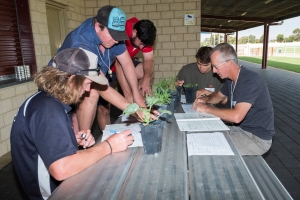How to get the most from your spraying program
How to get the most from your spraying program
Author: media@grdc.com.au | Date: 03 Mar 2020

Widespread, recent rain means many growers are embarking on weed control programs, and experts have advised of some simple precautions to help maximise their effectiveness.
Andrew Storrie, of AGRONOMO, encouraged growers to avoid making assumptions about emerging weeds, and to walk out into paddocks to identify weed species present and their growth stages.
“In southern coastal areas I have seen summer and winter weed species emerging, and they have been emerging quite slowly, due to relatively cool conditions and non-wetting soils in many areas,” he said.
“Rainfall received has also been very variable, and this will make a difference in terms of the weed burden and species present.”
Mr Storrie recently delivered Grains Research and Development Corporation (GRDC) workshops where growers learnt how to maximise the effectiveness of summer weed control, including how to correctly identify weed species at an early stage of development.
Information to assist growers to correctly identify WA summer weed species is available in the GRDC Identifying Western Australian summer weeds manual, authored by Mr Storrie.
Spray application specialist Bill Campbell advised growers to wait until they had achieved a good germination of weeds before embarking on spray programs, but not to wait too long, which could cause already-large spray programs to become unmanageable.
Mr Campbell advised that herbicide mixes needed to be adjusted, while adhering to label rates, according to the size of the weed and the species present.
“If hard-to-kill weeds like button grass or windmill grass are emerging, they will be difficult to control even when small and will require the high label rate of glyphosate in the tank mix,” he said.
Mr Campbell said that while conditions were mild and moisture levels remained good, weeds would not be stressed and should be relatively easy to control.
But he encouraged growers to be mindful of weather conditions, including the impact of hot days and evaporation on spray droplet survival, and the potential for spray drift. He said large droplets could compensate, to a degree, for warm conditions negatively impacting on droplet survival.
Mr Campbell urged growers to be aware of recommended ‘plant back’ or interval periods for certain herbicides, such as 2,4-D, which needed to be adhered to prevent herbicide residues damaging crops and pastures.
“This is especially important in paddocks where you are planning to sow lupins or canola early,” he said.
Mr Campbell said another consideration when using 2,4-D in herbicide mixes was the legal requirement to use droplet sizes at least ‘very coarse’.
“This means growers need to use robust water rates if applying herbicides to small weeds, and useful information is available in the GRDC Fact Sheet ‘Maintaining efficacy with larger droplets’,” he said.
Mr Campbell has been running GRDC sprayer calibration/application workshops in WA, and a further three workshops are due to be held in March: Manypeaks – (Thomson’s farm, 496 Thomson Road) – March 13; Broomehill (Bignell’s farm, Bignell Road) – March 17; and Compass Agriculture Alliance, Darkan (Buller’s farm, 970 Schinzig Road) – March 19.
More information about the workshops is available on the GRDC events page.
GRDC grower relations manager – west, Curtis Liebeck, encouraged growers to pay attention to the calibration of sprayers and to make sure they were in good working condition.
“It is also important to ensure chemicals and mixtures are correct for the weeds that are actually present, and to be conscious of herbicide breakdown periods,” he said.
“Some growers may be changing their paddock plans now, and it is important to make sure that the chemicals used will not impede cropping plans.”
Mr Liebeck advised growers to test water quality before using it to apply herbicides, as poor water quality could impact on the results.
The GRDC Spray Water Quality Fact Sheet contains information about water testing, including what should be measured and how to address any issues identified through testing.
Additional resources that may be useful for growers embarking on weed management programs include the GRDC Adjuvants Booklet and GRDC herbicide behaviour reference manuals and guides
Contact Details
For Interviews
Bill Campbell, spray application specialist
0427 545 553
bill@campbellag.com
Andrew Storrie, AGRONOMO
0428 423 577
andrew@agronomo.com.au
Curtis Liebeck, GRDC grower relations manager – west
0436 665 361
Curtis.liebeck@grdc.com.au
Contact
media@grdc.com.au – West
0427 189 827
media@grdc.com.au
GRDC Project Code: BCC1910-001SAX,
